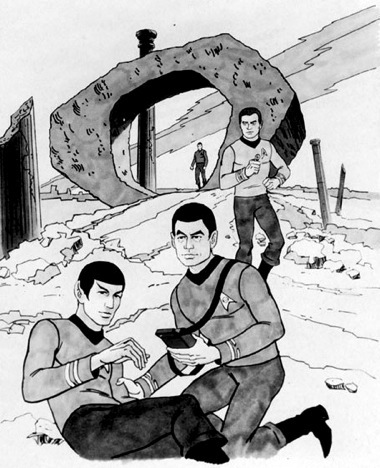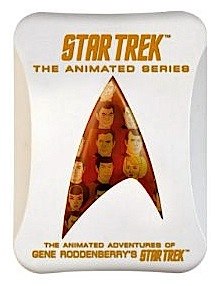Star Trek
The Animated Series
FYEO has been around for so long now, in one form or another, that we actually reviewed the then-new animated Star Trek series way back in the third issue, published in October 1973.
STAR TREK; created by Gene Roddenberry; starring the voices of William Shatner, Leonard Nimoy, DeForest Kelley, Nichelle Nichols, George Takei, Majel Barrett, James Doohan; directed by Hal Sutherland; executive consultant Gene Roddenberry; associate producer and story editor D.C. Fontana; produced by Lou Scheimer, Norm Prescott; a Filmation Production; Paramount Television.
Given the limitations of an animated half-hour TV show, the new Star Trek isn’t bad. It certainly stands head and shoulders above the rest of the unbelievably horrible trash on Saturday mornings. I still can’t believe such a low level of animation is necessary to produce a weekly series (you’d think it would at least be above the little-black-dots-for-eyes school of art). Any resemblance between the cartoon characters and the actors who originally played the parts is limited to having approximately the same color shirts and hair. The animation on any rapid motion is laughably incompetent. A few shots of the Enterprise are the only good visual aspects of the show, and unfortunately there are other shots of the ship that are completely lacking in any three-dimensional effect; you see a flat drawing of the ship being pushed across a flat drawing of outer space.
But you can always turn off the picture and just listen to the show, which is where it succeeds. Listening without watching, you can almost believe it’s the real, live-action Star Trek. All of the old series regulars except Walter Koenig are providing the voices of their characters, and though they often read their lines in an irritatingly slow and distinct manner, as if they were talking to a four-year-old, this is the best aspect of the program. Without those familiar voices the show would be much less acceptable, as can be seen when old characters turn up with typically ridiculous cartoon voices; Cyrano Jones and Captain Koloth, for instance, and Spock’s mother Amanda in “Yesteryear” (fortunately, Mark Lenard did Sarek’s voice).
Even the sound effects are usually the same as the ones heard in the old show. The music, while not up to prime time standards, is better than the stuff usually heard on Saturday mornings (though I guess anything would be a relief from the bubblegum rock used in the rest of those shows).
The stories themselves are shorthand versions of the kinds of stories seen in the original series. There’s virtually no characterization, as there’s barely time to get into a decent plot. They’re proceeding on the assumption that viewers already know the regular characters, and “guest roles” are expanded as necessary for each script. There have definitely been some interesting stories and alien lifeforms presented, including Ensign Erix (I guess that’s how it’s spelled), the lumpy alien who replaced Chekov as navigator, and who was just inexplicably there for the first few weeks (“What is that thing?” we cried, or “My God, Chekov’s been in some terrible space accident!”). Hopefully he will be featured in some future story.
With better art and animation this would be an outstanding effort, but it’s perfectly acceptable as is, either as a stopgap until a live-action version returns, or as Star Trek’s last stand.
The Series
That’s all we had to say after viewing just the first five or six episodes, and obviously we made a few errors. That really was Stanley Adams doing the voice of Cyrano Jones in the “More Tribbles, More Troubles” episode (but even in remastered Dolby Digital, it still doesn’t sound much like him). “Erix” was actually Arex, and it turned out he was not only orange and lumpy, he had three arms and three legs, which was impossible to discern at first since he never moved. Another alien semi-regular soon turned up, Lt. M’Hress, a purring female feline-type who sometimes served as communications officer in place of Uhura.
Walter Koenig, it soon was explained, was not included simply because paying the other seven regulars blew the budget, so in the time-honored tradition of last-hired-first-fired, he was dumped (but then he wrote a fairly interesting episode about a mad scientist’s plan to create an army of galactic peacekeepers by cloning Spock, and that led to an alternate career writing for TV and comic books).
Unfortunately, Chekov’s absence was never explained, which is one of many reasons the Trek fandom-industrial complex endlessly debates whether or not the animated stories are “canon” — even though it was one of these animated episodes that revealed the fact that James T. Kirk’s middle name is Tiberius, and everybody sure glommed onto that.
We also should have noted that Dorothy Fontana’s presence as associate producer and story editor was just as critical to the show’s success as getting the original cast on board, maybe even more so. As story editor and frequent writer on the original series, Fontana really made that the Star Trek we knew and loved (she and line producer Gene Coon, whose tragically early death in 1974 prevented him from ever receiving the full measure of credit he deserved). She succeeded in making the animated series a respectable continuation of Star Trek — sort of the fourth season that never was — and not the embarrassment it easily could have been (like, say, the original show’s imbecilic third season, produced by the hacks and morons who replaced Fontana, Coon and Roddenberry).
It’s almost impossible to remember now just how amazing it was in 1973 to see Star Trek back in production in any form, even as a Saturday morning cartoon show. And that no one knew if this really would be the last we ever saw of Trek (and maybe we’d be better off if it had been — but that’s an argument for another day). For that reason, Fontana and the writers obviously gave fans what they wanted in revisiting numerous aspects of the nighttime show while expanding somewhat into the kind of truly strange alien creatures and planetary vistas that could not have been shot in 1960s live-action.
This handful of animated episodes — 16 in the first season and a mere six in the second — was really the first attempt to start weaving what was established in the TV series into the Trek mythos that’s become so ponderous in the three decades since. In one episode, Spock uses Harlan Ellison’s Guardian of Forever to visit Vulcan’s past and the younger versions of the parents we met in “Journey to Babel.” Bob Wesley, commander of the Star Fleet war games in “The Ultimate Computer” turns up as the governor of a planet threatened with destruction. The crew runs into Cyrano Jones, Captain Koloth and another batch of tribbles. They have more problems with the amusement park planet seen in “Shore Leave.”
Kirk has another run-in with Klingon Captain Kor, and with Harry Mudd (the only character to make a return appearance in the original series). Spock’s life is threatened by the Orion pirates of “Journey to Babel.” And Commodore Robert April is introduced as the first captain of the Enterprise, since all Trek fans know Gene Roddenberry used that name for the ship’s captain in his original notes.
It was all so much innocent fun then.
THE DVDs
The DVD set is exactly what you’d expect — all 22 episodes, in excellent transfers (and surprisingly, they’re 24 minutes long — a Saturday morning cartoon show in the 70s was longer than prime time shows are today). Like everything connected with Star Trek, it’s ridiculously overpriced, so shop around for the best discount.
Special features include voice commentaries by some of the writers on their episodes, which generally are fun and informative, and pop-up text commentaries on others by anal Trek historian Michael Okuda, which get to be annoying.
A 25-minute documentary, “Drawn to the Final Frontier” (har har), is a brief but fairly comprehensive look at the series, interviewing the principal behind-the-scenes players from both the Star Trek and the Filmation sides (but not the actors — that would have required paying them and we all know how cheap Paramount is). A superficial text history of the show reveals nothing that fans haven’t known for years. And “What’s the Star Trek Connection?” is a completely pointless list of people and things seen in the original show that reappear in the animated show. It looks exactly like something a 15-year-old Trekkie was jotting down when the series first aired.
Star Trek
The Animated Series
Specs
From CBS DVD/CBS Paramount Network Television
Four discs, 22 episodes, each 23:30 to 24:10 minutes
Dolby Digital 2.0 mono, 5.1 surround
Spanish soundtrack Dolby Digital 2.0 mono
Subtitles in English, Spanish, Portuguese
Special Features
Commentary on selected episodes
“Drawn to the Final Frontier: The Making of Star Trek the Animated Series”
“What’s the Star Trek Connection?”
Storyboard Gallery
Released Nov. 21, 2006

A 1973 NBC still that more or less depicts a scene from the episode “Yesteryear.”




